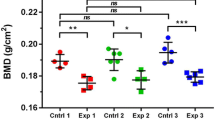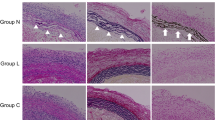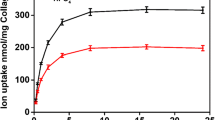Abstract
The relation between fluoride and calcification of the aorta has been studied in two systems: the intact rat and anin vitro preparation of the thoracic aorta incubated in serum. Vitamin D3 produced a ten-fold increment in calcium concentration and a twelve-fold increase in phosphate levels of the dry aorta. Fluoride did not affect the deposition of calcium, but significantly blocked the increase in phosphorus in the aorta of the vitamin D3-treated animals. In control rats, fluoride did not affect the incorporation of either calcium or phosphorus. The concentration of fluoride in the aortas of rats receiving only corn oil by intubation was not affected by long term exposure to drinking water containing 50 ppm F. Vitamin D3 produced a nine-fold increase in fluoride concentration in the aorta of the rats receiving fluoride in the drinking water when compared to the vitamin D3 rats receiving distilled water. It appears that long-term exposure to fluoride in the drinking water neither initiates calcification in the aorta nor potentiates calcification induced by vitamin D3. Von Kossa stain showed pronounced calcification of the aortas in rats receiving vitamin D3 but none was seen in the rats receiving distilled water alone. Resorcin-fuchsin-methyl green stain for elastic fibers showed destruction in regions of calcification in rats receiving vitamin D3 but not in those receiving fluoride alone. Fluoride did not appear to alter the histological picture seen in the aortas of rats receiving vitamin D3. In thein vitro model, rat thoracic aortas were incubated for 24 hours in rat serum containing45Ca and 0.14, 0.56 and 1.12 ppm F. Fluoride at all levels significantly inhibited45Ca uptake.
Résumé
Le rapport entre le fluor et la calcification de l'aorte a été étudié chez le rat intact et au niveau d'une préparationin vitro de l'aorte thoracique, incubée dans du sérum. La vitamine D3 provoque une augmentation de dix fois la concentration en calcium et une augmentation de douze fois la concentration en phosphate de l'aorte. Le fluor n'a pas d'action sur le dépot du calcium, mais il freine l'augmentation du phosphore de l'aorte des animaux traités à la vitamine D3. Chez les rats témoins, le fluor n'affecte pas l'incorporation du calcium ou du phosphore. La concentration en fluor des aortes des rats, ne recevant que de l'huile de germe de blé par sonde gastrique, n'est pas modifiée par l'administration prolongée de 50 p.p.m. de F à l'eau potable. La vitamine D3 provoque une augmentation de neuf fois la concentration en fluor de l'aorte de rats recevant du fluor dans l'eau potable, lorsqu'on les compare à ceux soumis à la vitamine D3 et à l'eau distillée. Is apparait ainsi que l'exposition prolongée à de l'eau potable fluorée ne favorise pas un début de calcification aortique et n'induit pas de calcification par l'intermédiaire de la vitamine D3. La coloration de von Kossa démontre une calcification intense des aortes de rat recevant de la vitamine D3. Une absence totale de dépôts calciques est notée chez les rats recevant seulement de l'eau distillée. La coloration à la résorcine-fuchsine vert de méthyle, pour la mise en évidence de fibres élastiques, montre une destruction de ces dernières dans les régions de calcification chez les rats recevant la vitamine D3. Ces lésions des fibres élastiques ne sont pas visibles chez les rats ne recevant que du fluor.
Zusammenfassung
Wir haben die Wirkung von Fluorid auf der Verkalkung der Aorta anhand folgender zwei Systeme untersucht: bei der Rattein vivo undin vitro an der Aorta thoracica, die in Serum inkubiert wurde. Durch Vitamin D3 wurde bei den Kontrollratten eine 10fache Erhöhung der Calcium-Konzentration und eine 12fache Zunahme des Phosphatgehaltes der Aorta verursacht; Fluorid beeinflußte diese Calcium-Ablagerung nicht, blockierte dagegen die Zunahme des Phosphors in der Aorta der mit Vitamin D3 behandelten Tiere. Bei den mit Maisöl behandelten Ratten beeinträchtigte Fluorid weder die Ablagerung von Calcium noch von Phosphor. Die Fluorid-Konzentration in den Aorten jener Ratten, die nur Maisöl durch die Magensonde erhielten, wurde selbst durch eine langfristige Einnahme von 50 ppm F enthaltendem Trinkwasser nicht beeinflußt. Die Aorten der mit Vitamin D3 behandelten Ratten, deren Trinkwasser Fluorid zugesetzt worden war zeigten im Vergleich zu den Vitamin D3-Ratten, die nur destilliertes Wasser erhielten, eine 9fache Zunahme der Fluoridkonzentration.
Somit scheint es, daß Fluorid im Trinkwasser über lange Zeit eingenommen weder eine Verkalkung der Aorta auslöste, noch eine durch Vitamin D3 verursachte Verkalkung zu potenzieren vermochte. Mit der von Kossa-Färbung konnten ausgeprägte Aortenverkalkungen der mit Vitamin D3 behandelten Ratten nachgewiesen werden, wogegen keine pathologischen Kalkablagerungen bei jenen Ratten gefunden wurden, die nur destilliertes Wasser erhielten. Die für elastische Fasern spezifische Resorcin-Fuchsin-Methylgrün-Färbung zeigte Zerstörungen in den Verkalkungszonen bei den mit Vitamin D3 behandelten Ratten, welche aber bei den Tieren, die nur Fluorid erhielten, nicht vorhanden waren.
Fluorid schien das histologische Bild der Aorten von Ratten mit Vitamin D3-Gaben nicht zu verändern.
Imin vitro-Modell wurden Aortae thoracicae von Ratten während 24 Stdn in Rattenserum inkubiert, welches45Ca sowie 0,14, 0,56 und 1,12 ppm F enthielt. Alle drei Fluoridkonzentrationen hemmten die Aufnahme von45Ca in signifikanter Weise.
Similar content being viewed by others
References
Baer, P. N., Stephan, R. M., White, C. L.: Studies on experimental calculus formation in the rat. I. Effect of age, sex, strain, high carbohydrate, high protein diets. J. Periodont.32, 190–196 (1961).
Bernstein, D. S., Sadowsky, N., Hegsted, D. M., Guri, C. D., Stare, F. J.: Prevalence of osteoporosis in high- and low-fluoride areas in North Dakota. J. Amer. med. Ass.198, 499–504 (1966).
Bellack, E., Schouboe, P. J.: Rapid photometric determination of fluoride in water. Analyt. Chem.30, 2032–2034 (1958).
Bunce, G. E., Jenkins, K. J., Phillips, P. H.: The mineral requirements of the dog. III. The magnesium requirement. J. Nutr.76, 17–22 (1962).
Call, R. A., Greenwood, D. A., LeCheminant, W. H., Shupe, J. L., Nielson, H. M., Olsen, L. E., Lamborn, R. E., Mangelson, F. L., Davis, R. V.: Histological and chemical studies in man on effect of fluoride. Publ. Hlth. Rep. (Wash.)80, 529–538 (1965).
Carlström, D., Engfeldt, B., Engström, A., Ringertz, N.: Studies on the chemical composition of normal and abnormal blood vessel walls. I. Chemical nature of vascular calcified deposits. Lab. Invest.2, 325–335 (1953).
Chiemchaisri, Y., Phillips, P. H.: Effect of dietary fluoride upon the magnesium calcinosis syndrome. J. Nutr.81, 307–311 (1963).
——: Certain factors including fluoride which affect magnesium calcinosis in the dog and rat. J. Nutr.86, 23–28 (1965).
Eichel, B., Morgenstern, S. W., Sobel, A. E.:In vitro calcification of mammalian aorta and rachitic bone. I. Histological studies. I.A.D.R. Pre-printed abstract No 10, 35th general meeting, 1957.
Eisenstein, R., Ellis, H., Rosato, J.:In vitro studies of vitamin D-induced aortic calcification. Proc. Soc. exp. Biol. (N.Y.)132, 58–62 (1969).
Ericsson, Y., Hammarström, L.: Autoradiographic localization of fluoride and calcium deposition in the atherosclerotic aorta of cholesterol-fed rabbits. Gerontologia (Basel)9, 150–156 (1964).
Faccini, J. M., Care, A. D.: Effect of sodium fluoride on the ultrastructure of the parathyroid glands of the sheep. Nature (Lond.)207, 1399–1401 (1965).
Fleisch, H., Schibler, D., Maerki, J., Frossard, L.: Inhibition of aortic calcification by means of pyrophosphate and polyphosphates. Nature (Lond.)207, 1300–1301 (1965).
Francis, M. D., Russell, R. G. G., Fleisch, H.: Diphosphonates inhibit formation of calcium phosphate crystalsin vitro and pathological calcificationin vitro. Science165, 1264–1266 (1969).
Gardiner, E. E., Rogler, J. C., Parker, H. E.: Interrelationships between magnesium and fluoride in chicks. J. Nutr.75, 270–274 (1961).
Gedalia, I., Binderman, I.: Effect of fluoride on hypervitaminosis D in rats. J. dent. Res.45, 825–829 (1966).
Gillman, T., Grant, R. A., Hathorn, M.: Histochemical and chemical studies of calciferol-induced vascular injuries. Brit. J. Exp. Path.41, 1–18 (1940).
Griffith, F. D., Parker, H. E., Rogler, J. C.: Observations on a magnesium-fluoride interrelationship in chicks. J. Nutr.79, 251–256 (1963).
Hac, L. R., Freeman, S.: Effects of fluoride and parathyroid extract on citrate and bone metabolism. Amer. J. Physiol.212, 213–216 (1967).
——: Effects of fluoride and vitamin D2 on citrate in bone and serum. Amer. J. Physiol.216, 179–184 (1969).
Harrison, M. F.: Fluoride content of tea as consumed in New Zealand. Brit. J. Nutr.3, 162–166 (1949).
Hodge, H. C., Smith, F. A.: Fluorides and man. Ann. Rev. Pharmacol8, 395–408 (1968).
Irving J. T., Schibler, D., Fleisch, H.: Effect of condensed phosphates on vitamin D-induced aortic calcification in rats. Proc. Soc. exp. Biol. (N.Y.)122, 852–856 (1966).
Kraintz, L.: The effect of fluoride ingestion on the response of the rat to parathormone and calcitonin. Canad. J. Physiol. Parmacol.47, 477–481 (1969).
Leipzig, L. J., McCann, D. S., Boyle, A. J.: The effect of oral sodium fluoride on aortic phosphate in experimental atherosclerosis. Life Sci.6, 999–1003 (1967).
Lillie, R. D.: Histopathologic technic and practical histochemistry. 3rd ed. New York: McGraw-Hill (Blakiston) 1965.
Lindberg, O., Ernster, L.: Determination of organic phosphorus compounds by phosphate analysis. In: Methods of biochemical analysis (Glick, D., ed.), vol. 3., p. 1. New York: Interscience Publ. Inc. 1956.
Martin, G. R., Schiffmann, E., Bladen, H. A., Nylen, M.: Chemical and morphological studies on thein vitro calcification of the aorta. J. Cell Biol.16, 243–252 (1963).
Molinari-Tosatti, M. P., Galzigna, L., Moret, V., Gotte, L.: Some features of the binding of calcium ions to elastin. Calc. Tiss. Res.2, 88, Suppl. (1968).
Morgenstern, S. W., Eichel, B., Sobel, A. E.:in vitro calcification of mammalian aorta and rachitic bone. II. Chemical studies. I.A.D.R. 35th general meeting. Abstract No 11, 1957.
Neuman, W. F., Neuman, M. W.: The chemical dynamics of bone mineral. Chicago, Ill.: University of Chicago Press 1958.
Pyke, R. E., Hoekstra, W. G., Phillips, P. H.: Effects of fluoride on magnesium deficiency in the guinea pig. J. Nutr.92, 311–316 (1967).
Raisz, L. G., Taves, D. R.: The effect of fluoride on parathyroid function and responsiveness in the rat. Calc. Tiss. Res.1, 219–228 (1968).
Rosenheim, A. H., Robinson, R.: The calcification in vitro of kidney, lung and aorta. Biochm. J.28, 712–719 (1934).
Schibler, D., Russell, R. G. G., Fleisch, H.: Inhibition by pyrophosphate and polyphosphate of aortic calcification induced by vitamin D3 in rats. Clin. Sci.35, 363–372 (1968).
Schiffmann, E., Martin, G. R.:In vitro calcification in rat aorta in serum. Nature (Lond.)194, 189–190 (1962).
—, Corcoran, B. A., Martin, G. R.: The role of complexed heavy metals in initiating the mineralization of “elastin” and precipitation of mineral from solution. Arch. Biochem.115, 87–94 (1966).
—, Martin, G. R., Corcoran, B. A.: The role of the matrix in aortic calcification. Arch. Biochem.107, 284–291 (1964).
Singer, L., Armstrong, W. D.: Normal human serum fluoride concentration. Nature (Lond.)214, 1161–1162 (1967).
Singh, A., Singh, B. M., Singh, I. D., Malhotra, K. C.: Parathyroid function in endemic fluorosis. Indian. J. med. Res.54, 591–596 (1966).
Smith, F. A., Gardner, D. E., Leone, N. C., Hodge, H. C.: The effects of the absorption of fluoride. V. The chemical determination of fluoride, in human soft tissues following prolonged ingestion of fluoride at various levels. Arch. industr. Hlth21, 330–332 (1960).
Spector, M., Krokosky, E. M., Sax, M., Pletcher, J.: Atherosclerotic plaque: X-ray diffraction investigation. Science165, 711 (1969).
Stookey, G. K., Muhler, J. C.: Relation between fluoride deposition and metastatic calcification in soft tissues of rat and guinea pig. Proc. Soc. exp. Biol. (N. Y.)113, 720–725 (1963).
Taves, D. R.: Evidence that there are two form of fluoride in human serum. Nature (Lond.) (1968).
Turner, G. K.: Associates: Manual of fluorimetric chemical procedures. 2524 T Pulgas Avenue, Palo Alto, California, 94303 (1966).
Urist, M. R., Adams, J. M., Jr.: Localization mechanism of calcification in transplants of aorta. Ann. Surg.166, 1–18 (1967).
Waldbott, G. L.: Fluoride and calcium levels in the aorta. Experientia (Basel)22, 835–837 (1966).
Wuthier, R. E., Irving, J. T.: A study of the lipids of the rat aorta during induced calcification. Proc. Soc. Exp. Biol. (N. Y.)130, 156–162 (1969).
Young, W., Hotovec, R. L., Romero, A. C.: Tea and atherosclerosis Nature (Lond.)216, 1015–1016 (1967).
Yu, S. Y., Blumenthal, H. T.: The calcification of elastic tissue. In: The connective tissue (Wagner, B. M., and D. E. Smith, eds.), p. 17–49. Baltimore: Williams and Wilkins Company 1967.
Zipkin, I., McClure, F. J.: Complex fluoride: Caries reduction and fluorine retention in the bones and teeth of the white rat. Publ. Hlth Rep. (Wpsh.)66, 1532–1532 (1951).
— Lee, W. A., Leone, N. C.: Fluoride content of urinary and biliary tract calculi. Proc. Soc. exp. Biol. (N. Y.)97, 650–653 (1958).
Author information
Authors and Affiliations
Additional information
Work done at the National Institute of Dental Research, NIH, Bethesda, Maryland, U.S.A.
Rights and permissions
About this article
Cite this article
Zipkin, I., Zucas, S.M., Lavender, D.R. et al. Fluoride and calcification of rat aorta. Calc. Tis Res. 6, 173–182 (1970). https://doi.org/10.1007/BF02196198
Received:
Accepted:
Issue Date:
DOI: https://doi.org/10.1007/BF02196198




